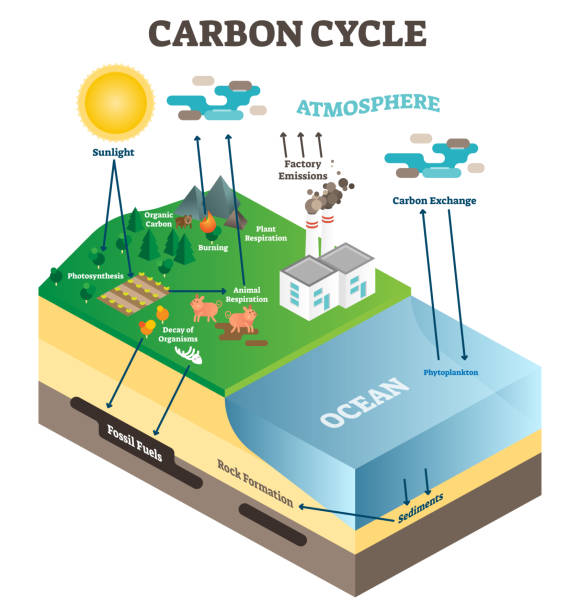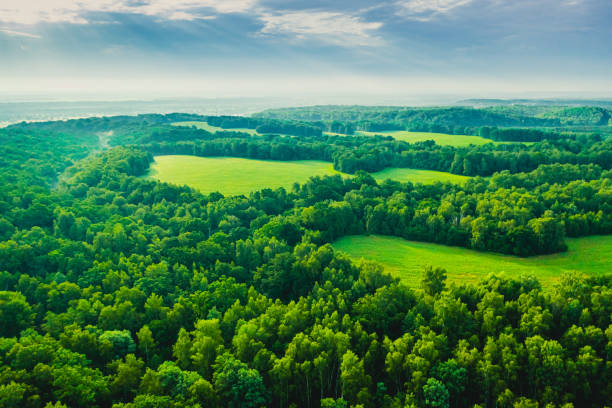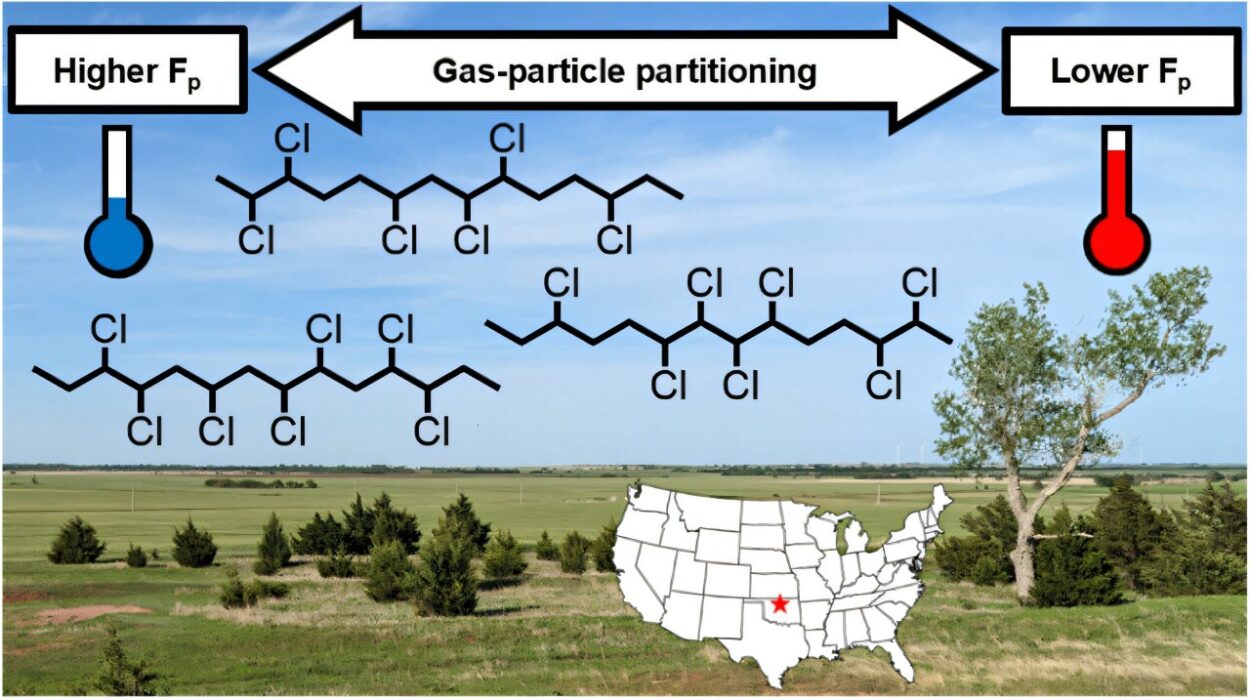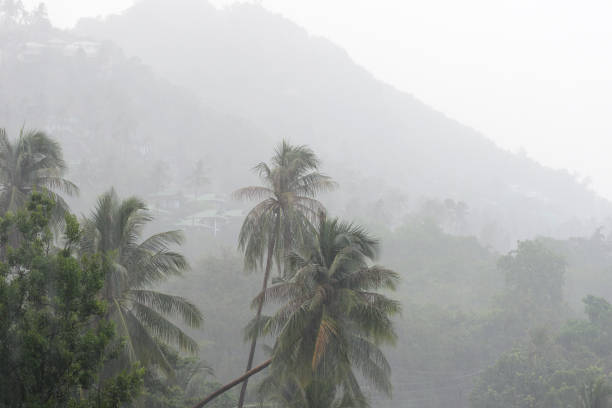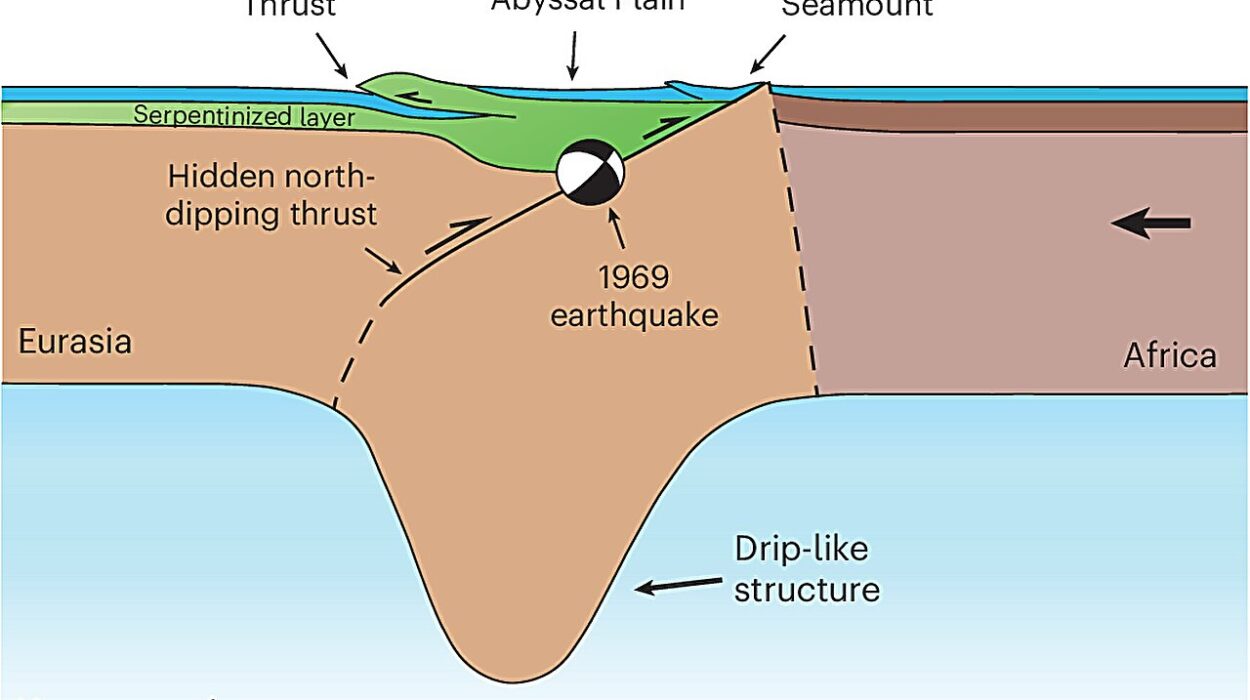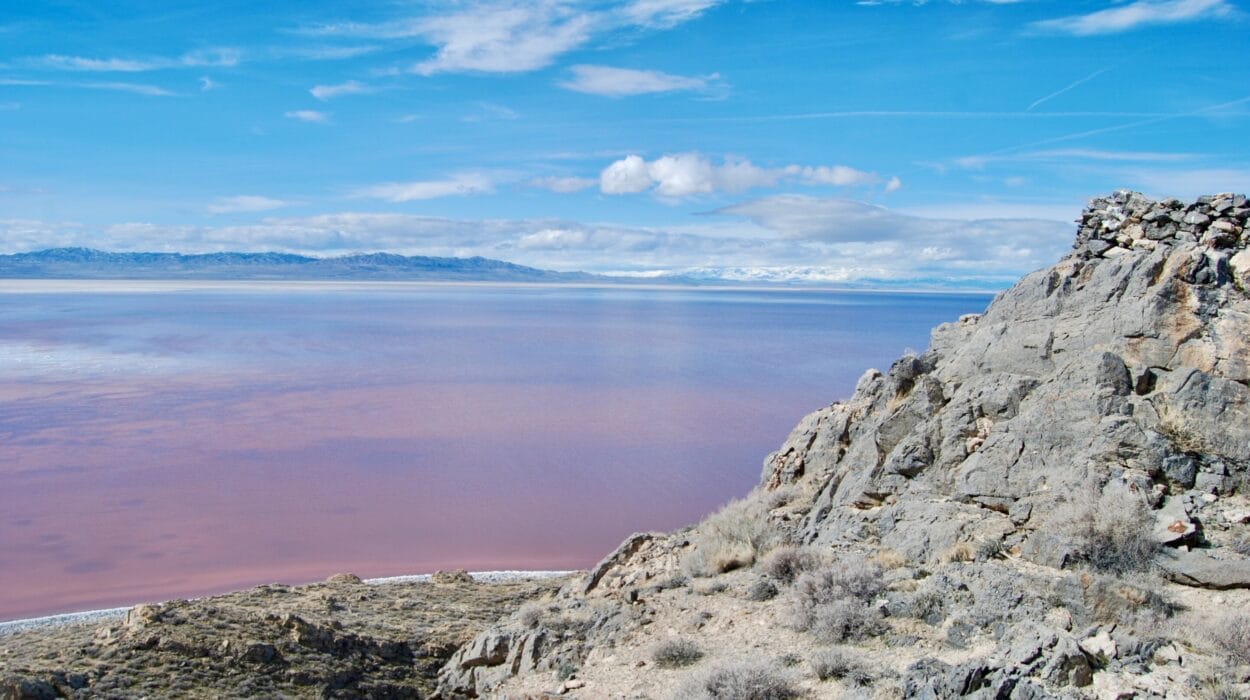Earth is alive in more ways than we usually imagine. It breathes—not with lungs or windpipes—but with forests and oceans, volcanoes and soil. And at the center of this slow, powerful respiration lies the carbon cycle. It is one of the most important processes on the planet, moving carbon—the building block of life—through the atmosphere, land, ocean, and living beings. It doesn’t just support ecosystems. It regulates the climate. It governs the rhythm of warming and cooling. And today, in the age of industry and urgency, it stands at the center of the climate crisis.
To truly understand the changing climate of our world, we must first understand the cycle that regulates it. The carbon cycle isn’t just about chemistry or geology. It is about life. It is the heartbeat of Earth’s climate system. And as humans, we have become a powerful part of this story—for better or worse.
Carbon: The Element of Life and Fire
Before diving into the cycle itself, let us first consider the nature of carbon. It’s the sixth element on the periodic table, but its role in the cosmos is anything but minor. Carbon is the scaffold of life. Our cells, our DNA, the air we exhale, and the food we eat all depend on this extraordinary atom. Its ability to form strong, stable bonds makes it the ideal foundation for complex molecules—proteins, carbohydrates, fats, and more.
But carbon is also found in rocks and fuels, dissolved in oceans, and floating in the atmosphere. In the form of carbon dioxide (CO₂), it is a greenhouse gas, invisible yet vital. Without it, Earth would be a frozen wasteland. With too much, it becomes a feverish planet. It’s a paradox: the same gas that makes life possible can also push it toward collapse.
A Journey Through the Carbon Cycle
The carbon cycle describes how carbon moves between the atmosphere, biosphere, oceans, and geosphere. It’s not a single path but a web of interconnected routes, driven by natural processes—and now increasingly by human activities.
Every breath you take, every tree that grows, every wave that crashes against a cliff is part of this cycle. Let us follow carbon on its journey.
It begins with the atmosphere, where carbon exists primarily as carbon dioxide. Plants draw this gas from the air during photosynthesis. With the help of sunlight, they turn carbon dioxide and water into glucose and oxygen. This is the most elegant of transformations: invisible gas into solid life. Forests, grasses, and phytoplankton in the ocean perform this miracle daily, pulling down CO₂ and locking it into biomass.
When animals eat plants, they inherit that carbon. Some is used to build bones and muscles. Some is stored. And much of it, eventually, is released again—through respiration, decay, or fire—back into the atmosphere.
But not all carbon returns immediately. Some is buried. Dead plants and marine organisms, sinking to the bottom of oceans and wetlands, can be trapped in sediments. Over millions of years, pressure and time transform this buried carbon into fossil fuels: coal, oil, natural gas. These are ancient carbon stores—locked away and inert. Until we dig them up.
Oceans also absorb carbon directly from the air. Cold water, especially near the poles, acts like a sponge, pulling in CO₂ and holding it in deep currents for centuries. Some of it is used by tiny marine organisms to build shells, which eventually settle into the ocean floor as limestone and chalk. In this way, carbon can be trapped for millions of years in the crust of the Earth.
Volcanoes, weathering, and tectonic shifts can bring it back again. The Earth itself exhales. But compared to human industry, the natural processes are slow and balanced—until that balance is broken.
Earth’s Ancient Climate Control System
The carbon cycle acts like Earth’s thermostat. The more carbon dioxide in the atmosphere, the warmer the planet becomes. Less CO₂, and the climate cools. Over geological time scales, this has helped regulate Earth’s temperature. Ice ages came and went. Lush tropical periods alternated with glaciated epochs. And through it all, the carbon cycle ticked on, slow and steady.
During cooler periods, chemical weathering of rocks increased. Carbon dioxide was pulled from the air and locked into minerals. During warmer periods, the opposite occurred. Forests expanded, oceans outgassed more CO₂, and warming continued. These feedback loops maintained a relative equilibrium.
Until, of course, humans began to change the game.
A New Player: Humans and the Carbon Disruption
For 800,000 years, atmospheric CO₂ levels hovered between 180 and 300 parts per million (ppm). Then came the Industrial Revolution. With the invention of coal-burning steam engines, the great reservoirs of ancient carbon began to be unlocked. Factories, locomotives, and furnaces filled the air with invisible clouds of carbon dioxide. And the numbers began to climb.
By 1950, atmospheric CO₂ had reached 310 ppm. By 2024, it exceeded 420 ppm. This change may seem small, but it is not. It is a seismic shift in the planet’s energy balance. The Earth is absorbing more heat than it releases. Ice is melting. Oceans are warming. Storms are intensifying. And the thermostat is spinning out of control.
Human activities now release over 35 billion tons of CO₂ into the atmosphere every year. That’s 100 times more than volcanoes emit globally. Deforestation adds to the problem by removing carbon sinks—forests that once absorbed CO₂ now burn or rot, releasing it instead.
The result is climate disruption on a global scale.
Oceans: The Carbon Sink with a Tipping Point
The oceans have long been silent allies in the fight against warming. They absorb nearly a quarter of the CO₂ we emit. But this comes at a cost. When carbon dioxide dissolves in seawater, it forms carbonic acid, lowering the ocean’s pH. This process, known as ocean acidification, threatens coral reefs, shellfish, and countless marine organisms.
The chemistry is straightforward but devastating. As acidity rises, calcium carbonate—the material used by many sea creatures to build shells and skeletons—becomes harder to form. Corals bleach and weaken. Shellfish struggle to survive. Plankton populations change. And with them, entire food chains begin to collapse.
Oceans also have a limit. Warmer waters absorb less CO₂. As the planet heats up, the ocean’s capacity to act as a carbon sink diminishes. Worse, warming may trigger the release of methane—a far more potent greenhouse gas—from seafloor clathrates and thawing Arctic permafrost. This feedback loop could accelerate warming further.
Forests: Breathing In, Burning Out
Forests are among the most powerful tools we have for regulating carbon. Tropical rainforests like the Amazon, temperate woodlands, boreal conifer stands—they all pull carbon from the air and store it in wood and soil.
But they are under siege.
Deforestation, driven by agriculture, mining, and logging, is stripping the planet of its lungs. Fires—many set intentionally—release stored carbon in huge pulses. In the Amazon alone, deforestation has reduced the forest’s ability to act as a carbon sink. In some places, it has even become a net source of CO₂.
Reforestation and forest conservation are essential solutions. But they must be matched with emissions cuts to be effective. Planting trees cannot undo decades of fossil fuel combustion on its own.
Soils and Microbes: The Hidden Players
Beneath our feet, another carbon reservoir operates silently. Soils contain more carbon than the atmosphere and all living plants combined. This carbon is stored as organic matter—roots, decomposing leaves, microbial biomass. Healthy soils pull CO₂ from the air and lock it away. But when soils are degraded—by over-farming, erosion, or warming—they release that carbon back into the atmosphere.
Microbes play a vital role in this underground cycle. They decompose organic matter, respiring CO₂ in the process. In balance, they help recycle nutrients. In disturbed systems, they can become carbon sources.
Improving soil health—through regenerative agriculture, cover cropping, reduced tilling—can turn farms into powerful carbon sinks. It is a win-win: healthier food systems and a more stable climate.
Carbon Budget: How Much Can We Emit?
Scientists use the concept of a carbon budget to determine how much more CO₂ humanity can release before exceeding critical warming thresholds. To keep global warming below 1.5°C, the world must limit cumulative CO₂ emissions to roughly 500 billion more tons.
At current rates, we will reach that limit within a decade.
This is why the carbon cycle matters so much. It is not merely an academic curiosity. It is the key to understanding how much we can emit, how fast we must act, and what solutions are possible. It is the map for navigating our climate future.
Carbon Capture and Future Technologies
In recent years, attention has turned to carbon capture technologies. These include natural solutions—like reforestation and wetland restoration—and engineered approaches like Direct Air Capture (DAC), which literally sucks CO₂ from the air and stores it underground.
While promising, these technologies are still expensive and limited in scale. Relying on them without reducing emissions is like bailing water from a sinking boat without fixing the leak. They must be part of a broader strategy—not a substitute for action.
The Story We Tell Ourselves
Understanding the carbon cycle is not just about atoms and molecules. It is about choices. For centuries, humans have altered the landscape, extracted energy from the Earth, and shaped ecosystems. Now, we are shaping the atmosphere itself.
The carbon cycle is the story of Earth breathing. But it is also a mirror—reflecting the consequences of our decisions. The forests we burn, the oil we pump, the oceans we warm—these are not abstract. They are direct interventions in the planet’s metabolism.
But stories can change. And the carbon cycle, while altered, is not broken. If we reduce emissions, protect ecosystems, and restore balance, Earth can heal. The same natural processes that once kept the planet in harmony still operate. They are waiting—quietly, patiently—for us to realign with them.
The Road Ahead: A Planet in Our Hands
Climate change is not just a crisis of carbon. It is a crisis of connection. We have forgotten that we are part of the cycles we disrupt. That every car ride, every tree cut, every factory plume alters the delicate balance that sustains life.
But knowledge is power. Understanding the carbon cycle empowers us to make informed choices. It shows us where to focus: energy, agriculture, forestry, industry. It offers a blueprint for survival—and a future worth building.
We must act not just for the climate, but for the carbon storytellers themselves: the whales, the redwoods, the microbes, the clouds. We are all entangled in this ancient dance of atoms.
The carbon cycle isn’t only about carbon.
It’s about life. It’s about breath. And now, it’s about us.
